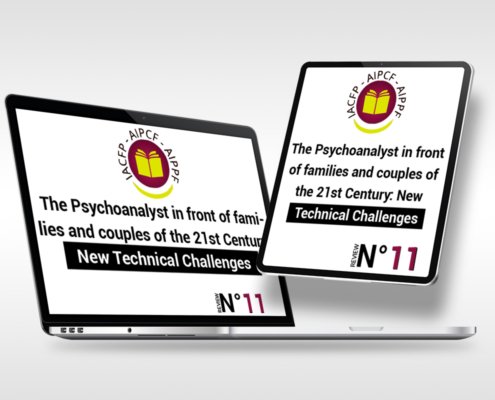REVIEW N° 11 | YEAR 2012 / 1
EDITORIAL
DAVID BENHAÍM, EZEQUIEL A. JAROSLAVSKY
This eleventh issue of the International Journal of Couple and Family Psychoanalysis gathers some of the papers presented at the Fifth Congress of the International Association of Couple and Family Psychoanalysis, which took place in Padua in July of 2012. Its theme was: Psychoanalysts working with families and couples of the twenty-first Century: New technical challenges.
As the program of the Congress suggested: “The new challenge for couple and family psychoanalysis is in resonance with changes occurring in different fields of work of psychoanalysts, which centers around articulation between subjectivity, intersubjectivity, family groupality and psychic processes consubstantial with social groupings. The issue of the growing complexity of listening in session and technical adaptations required is discussed. The severity of psychopathologies treated also tests clinicians’ psychic survival.
Having integrated their own internal resources and subjective and conceptual categories, analysts assign a primordial function to their experiencing. Their subjective experience enables them to propose, by virtue of their potential for freedom and creativity, non-conventional settings that are not however transgressive. A few examples are: family psychodrama, co-therapy, different mediations and technical combinations.
These changes lead to new concepts and review of more classical concepts; papers on links have broadened the field of knowledge of relations between subjects and group of pertinence. In the light of intersubjectivity and the group situation, and based on link metapsychology, the concepts of drive, family narcissism, identity, subject, superego, mutual recognition, attachment and unconscious alliance call for reconsideration.”
It is in this context that we recommend reading the articles published in this issue.
The authors of the article Penser le corporel dans la famille. Obésité paradigme de la limite [Thinking about the body in the family. Obesity as a paradigm of limits], Almudena Sanahuja and Patrice Cuynet, propose “to define a body image of the unconscious structure of families linked to obesity.” The authors did this research study in a specialized clinic with 23 cases of obesity.
The paper Mediation Techniques in Couple and Family Therapy: Two Clinical Vignettes by Ondina Greco is a study of technical mediations in couple and family therapy, illustrated with two clinical vignettes. She discusses the efficacy of the use of graphic work such as projective graphic instruments, free drawings and thematic drawings.
The article Ocupar y habitar diferentes operaciones vinculares [Occupyng and inhabiting different link operations] by Sonia Kleiman starts with a question: “How to occupy the place of the mother, the father, the teacher or the analyst today?” which serves to formulate a problem. Does this question mean the same today as it did in the past? The author insists that there is a gap between what is expected to happen in these situations, based on predetermined discourse, and what actually occurs in this experience.
In La interpretación en las terapias psicoanalíticas de pareja y de familia: El toque final [Interpretation in psychoanalytic couple and family therapies: the last touch], Alberto Eiguer focuses on the subject of interpretation in couple and family therapies. After considering analogies and differences between these therapies, the author describes how the technique of psychoanalytic group therapy may be applied to these therapies from the perspective of interpretation.
The paper Family psychoanalysis: the analytic setting and its variations by Daniela Lucarelli and Gabriela Tavazza reflects on the analytic setting and its variations, which the authors discuss in view of complex problems that have been part of their history and remain unresolved even today.
The article, Nous avons rêvé un enfant: la thérapie psychanalytique comme un setting mythopoietique pour les couples avec une maladie génétique [We dreamed of a child: psychoanalytic therapy as a mythopoietic setting for couples with genetic illness], by Alexandra Sá and Carina Brito da Mana, views psychoanalytic couple therapy as a mythopoietic setting for couples afflicted with genetic illness. The authors present a couple at risk of having a dwarf child and who consult when they are going through a marital crisis.
The following article, Ocupando el lugar del familiar muerto [Occupying the place of the dead relative], by Ruth Levisky, analyzes the reactions of patients immersed in grief for the loss of a close relative and attempt to take the relative’s place, generating a situation in which their identity eventually becomes mixed with the dead person’s identity.
The paper, La pareja terapéutica en la coterapia: el trabajo intertransferencial [The therapeutic couple: intertransference work] by Maximiliano Sommatico reflects on intertransference work in co-therapy. The author presents a clinical example to highlight the specificity of the intersubjective dynamic that develops in the therapeutic couple as well as in the couple in therapy.
The next article, Family psychoanalytical psychotherapy: clinical material regarding simultaneous psychoanalytical therapy of parents and minor by F. Spadaro, M.G. Reina, L. Pistorio, F. Forti and G. Pistorio, presents clinical material of a family that consults in a state of affective impasse due to the symptomatology of a minor. The authors describe the development of the therapy and its eventual effects.
In Multiple transferences in couple analysis Ludovica Grassi presents the case of a couple with different geographic and cultural origins. The author particularly emphasizes transference and countertransference interactions of both individual and group, as well as the depressive dimension, which may conceal unworked on mourning.
In the Book Reviews section David Benhaïm gives us extensive commentary on the recently published work, Le Malêtre by René Kaës.
Finally, we wish to express our thanks to the members of the editorial and reading committee of the journal, and also to the colleagues who have contributed with their papers to the publication of this issue.
David Benhaïm
Ezequiel A Jaroslavsky
Co-Editors
Journal of the AIPPF

